
87 Results


In this module we will explore the concept of a confidence interval to estimate an unknown population parameter. Specifically, we will obtain confidence interval estimates for unknown population mean and for unknown population proportion. We will also find how large a sample we would require to estimate these parameters for any given amount of accuracy and confidence level.Learning Objectives:Construct and interpret a confidence intervalStudent’s t-distributionStandard error and margin of errorSample size estimationTextbook Material - Chapter 8 – Confidence Intervals – pages 439 - 463Suggested Exercises – Odds 97 – 134
- Subject:
- Statistics and Probability
- Material Type:
- Module
- Date Added:
- 07/03/2018


Included here are resources found in individual topics. These includeOpenStax Textbook Introductory Statistics by Barbara Illowsky and Susan Dean (senior contributing authors) in pdf format.Class Worksheets, Spreadsheets and Course Final Project developed by Statistics Team -Sara Rollo, Assistant Professor, Mathematics,College Mathematics Program Coordinator, North Central State College, 2441 Kenwood Circle, Mansfield, Ohio 44906Nicholas Shay, Assistant Professor of Mathematics, Central Ohio Technical Colleg, 165 Hopewell Hall, Newark, OH 43055Emily Dennett, Assistant Professor of Mathematics, Central Ohio Technical Colleg, 165 Hopewell Hall, Newark, OH 43055Chan Siriphokha, Assistant Professor, Clark State CC, Greene Center, 3775 Pentagon Blvd, Beavercreek, OH 45431Dr. Kameswarrao Casukhela, Senior Lecturer, Department of Mathematics, The Ohio State University at Lima, 4240 Campus Drive, Lima, Ohio 45806Quick Adoption Guide
- Subject:
- Statistics and Probability
- Material Type:
- Module
- Author:
- Sara Rollo
- Nick Shay
- Chanpathana Siriphokha
- Kameswarrao Casukhela
- Date Added:
- 09/06/2018

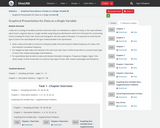
A data set is a listing of variables and their observed values on individuals or objects of study. In this topic we will learn about how to organize data on a single variable using frequency distributions which form the basis for constructing charts including Pie Charts, Bar Charts and Histograms. We also explore Stemplot. It is important to note that the type of chart to be used depends on the type of data/variable to be represented.Given a data set be able to construct a frequency table, find and interpret relative frequency of a value, find and interpret cumulative frequency.For categorical data make and interpret a Pie chart and a Bar Chart. Further know when to construct each type of chart, their relative advantages and limitations.For quantitative data be able to make and interpret Stemplot, Histogram, Frequency Polygon, Ogive, Time Series Graph. Further know when to construct each type of chart, their relative advantages and limitations. Textbook Material - Chapter 1 – Sampling and Data – pages 13 – 19Chapter 2 – Descriptive Statistics – Pages 67 – 88
- Subject:
- Statistics and Probability
- Material Type:
- Module
- Date Added:
- 07/02/2018


- Subject:
- Statistics and Probability
- Material Type:
- Module
- Author:
- Mindy Boland
- Date Added:
- 03/20/2018

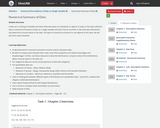
A data set is a listing of variables and their observed values on individuals or objects of study. In this topic we will learn about numerical summaries of data on a single variable and learn how to use them to describe data distribution and determine unusual values in the data. The type of numerical summaries to use depend on the data. We will also learn about boxplots.Learning Objectives:Understand which numerical summaries must be used to represent dataBe able to compute and interpret them. Also, know their properties and relative advantages and disadvantages. Further, use these measures to describe distributions, compare values from distributions, detect unusual values in the data, etc.For categorical data use counts and proportions to describe categoriesFor quantitative data useMeasures of Center – Mean, Median, ModeMeasure of Spread – Range, Interquartile Range (IQR), Variance and Standard DeviationMeasures of Location – Minimum, Maximum, Quartiles and PercentilesLearn to distinguish between different types of distributions for quantitative data – symmetric, skewed, bell-shaped, multimodal distributionsLearn about Empirical Rule for bell-shaped distributionsUse z-scores to compare values and detect unusual valuesMake boxplot of dataTextbook Material: Chapter 2 – Descriptive Statistics – Pages 88 - 122Suggested HomeworkChapter 2 - Descriptive Statistics – 29, 31, 32, 43, 57, 60, 69, 71, 82, 84, 86, 88, 89, 104, 106, 108, 109, 115, 119
- Subject:
- Statistics and Probability
- Material Type:
- Module
- Date Added:
- 07/02/2018

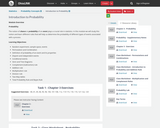
ProbabilityThe notion of chance or probability of an event plays a crucial role in statistics. In this module we will study this notion and learn different rules that will help us determine the probability of different types of events associated with a process.Learning Objectives:Random experiment, sample space, eventsPermutation and CombinationDefinition of probability of an event and its propertiesDisjoint and independent eventsConditional eventsVenn and Tree DiagramsComplement (Subtraction) ruleAddition ruleMultiplication ruleDivision ruleTwo-Way tablesTotal Probability Rule and Bayes Rule
- Subject:
- Statistics and Probability
- Material Type:
- Module
- Date Added:
- 07/03/2018

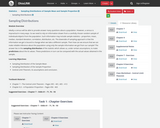
Ideally a census will be able to provide answers to many questions about a population. However, a census is impractical in many ways. So we need to rely on information drawn from a carefully chosen random sample of individuals/objects from the population. Such information may include sample statistics - proportion, mean, median, standard deviation, correlation, distribution, etc. The downside of the sampling approach is that the information we get is bound to change when we take a different sample. Then how can we ensure that we can make reliable inference about the population using only the sample information we got from our sample? The answer lies in the sampling distribution of the statistic which allows us, under certain assumptions, to make predictions about its values. These predictions, in turn, can be compared with the actual values obtained in the sample.Learning Objectives:Sampling Distribution of the Sample MeanSampling Distribution of the Sample ProportionCentral Limit Theorem, its assumptions and conclusion. Textbook Material - Chapter 7 – The Central Limit Theorem – Pages 395 – 401, 405 – 413Suggested Exercises – Chapter 7 – Odds 61 – 71, 76 – 93
- Subject:
- Statistics and Probability
- Material Type:
- Module
- Date Added:
- 07/03/2018

- Subject:
- Mathematics
- Statistics and Probability
- Material Type:
- Unit of Study
- Provider:
- Ohio Open Ed Collaborative
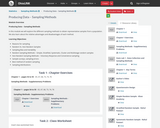
Producing Data – Sampling MethodsIn this module we will explore the different sampling methods to obtain representative samples from a population. We also learn about the relative advantages and disadvantages of each method. Learning Objectives:Reasons for samplingRandom Vs. Non-Random SamplesSampling Bias and VariabilityRandom Sampling Methods – Simple, Stratified, Systematic, Cluster and Multistage random samplesNon-Random Sampling Methods – Voluntary Response and Convenience samplingSample surveys, sampling errorsBest method of random samplingSampling distributions
- Subject:
- Statistics and Probability
- Material Type:
- Module
- Date Added:
- 07/02/2018

- Subject:
- Mathematics
- Statistics and Probability
- Material Type:
- Unit of Study
- Provider:
- Ohio Open Ed Collaborative

This module contains Excel and Google Spreadsheets for all statistical procedures used in an Intro Stats course. The spreadsheets are self-explanatory. Students insert data in the indicated areas. Spreadsheets are designed to automatically complete all calculations and show the results.One Variable Statistics Frequency DistributionDiscrete Probability DistributionNormal DistributionConfidence IntervalsTest of HypothesisLinear RegressionIndependence
- Subject:
- Statistics and Probability
- Material Type:
- Module
- Date Added:
- 07/03/2018

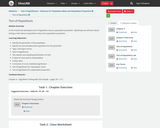
In this module we will explore tests of hypotheses about a population parameter. Specifically, we will learn about testing a claim about a population mean and a population proportion. Learning Objectives:Identify the parameter of the populationSpecify the null and alternative hypotheses for the parameterType I and Type II errorsLevel of significanceTest statistic and sampling distribution of a testP-value of a test and its interpretationCritical valueConclusion of a test, Statistical significanceTest of hypothesis for a population meanTest of hypothesis for a population proportionTextbook Material - Chapter 9 – Hypothesis Testing with One Sample – pages 501 - 511
- Subject:
- Statistics and Probability
- Material Type:
- Module
- Date Added:
- 07/03/2018